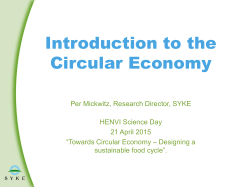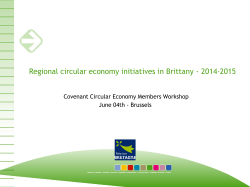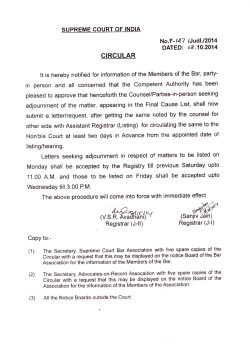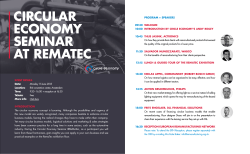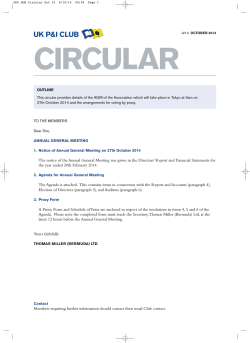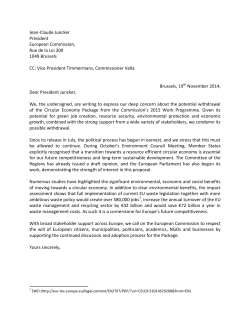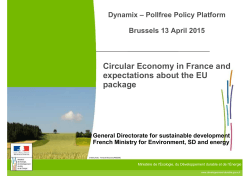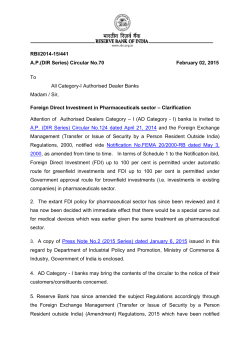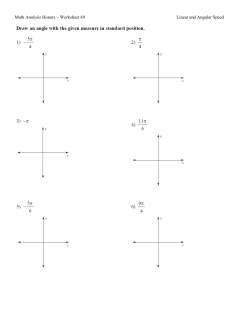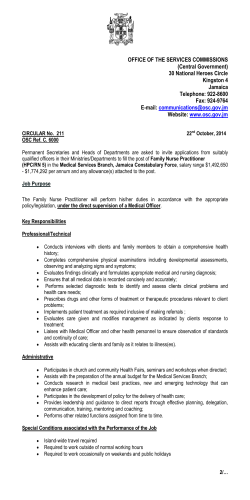
Comment from AmCham Customs & Trade Facilitation Committee
Seminar calling for business comments on draft Circular replacing Circular 20 on imports of used machinery, equipment and production lines. VCCI Ho Chi Minh, 171 Vo Thi Sau, Ward 7, D3, HCMC 10F Meeting Room Tuesday, Mar 17, 2015 8:00am – 11:30am Comment regarding the draft circular to replace Circular 20/2014/tt-bkhcn, hanoi, 15 july 2014, Regulations for used machinery, equipment and technological line imports. effective 1 sep 2014. 1 The Circular is expressly intended to encourage imports of new machinery, equipment and production lines that are manufactured with the latest technology, presumably to enhance economic growth and development. Regrettably, the new restrictions in the draft Circular are likely to have an effect opposite to that intended. A practical example: progressive dies or other specialized new tooling and high-tech controls items are used with multi-ton and multi-year capital equipment such as, stamping presses or machine tools in many industrial applications. While the dies, specialized tooling and computerized controls items may be new, the presses and machine tools in which they are used have useful lives of many years, well exceeding the limits of “10 years” or “remaining quality of 80% or higher” stated in the draft Circular. Rather than restriction, the goal of encouraging imports of manufacturing equipment for high technology industries is better served by providing new duty and tax incentives for investment in such new equipment and technologies. The restrictions in the draft circular will actually discourage such investments and imports because of likely unintended coverage of long-term capital equipment, parts and accessories due to the broad scope of the Harmonized System customs classification codes involved. The consideration of slowing or limiting transfer of useful high-technology manufacturing equipment to Vietnam is particularly applicable to machines and equipment used for semiconductor, automotive, flat panel, optical and solar cell industries. This is because it is faster and more cost-effective for an investor to obtain high-quality used manufacturing machines for this industry, often moving equipment from an existing factory in another country, for example, China, Mexico, Costa Rico, Malaysia, etc., than to order new equipment because of long lead times for such equipment and greater expense. Here is what a company in California that specializes in such equipment reports: “...Since the demand for used semiconductor fabrication equipment gained traction in the late 1990s, around 2,000 companies emerged worldwide as buyers and sellers. The reason for the demand for used or remanufactured equipment remains the same as when SEC/N President Gary Alexander stated in 2000: ‘ … that quality remanufactured equipment is often available at a fraction of the cycle time and cost of new equipment.’ 1 http://www.dncustoms.gov.vn/web_english/english/btc/20_TT_BKHCN_15_7_2014.htm 1 “In today’s world of multi-million dollar capital equipment, the cost savings when buying used can average as much as 50%. While the benefit of lower costs continues to be a primary driver, other considerations have emerged as critical factors such as installation, parts availability, maintenance, service, quality, training and safety…"2 The new draft Circular is also intended to ensure that such goods meet requirements of quality, safety, energy saving and environment protection. However, instead of enacting new trade-restricting measures, a better approach that involves modernization and enhancement of existing compliance regulations and their enforcement by regulatory agencies through upto-date implementation of international standards and electronic processing of administrative procedures is recommended. Such an approach will be in keeping with international trade agreement requirements for implementation of the National Single Window by Vietnam. We recommend that the standard for “Quality” that is specified as “remaining quality of 80% or higher” be defined in greater detail through objective measures, based on international standards, because “quality” of machines and equipment is typically defined by performance specifications of specific machines and equipment, according to their purpose. For example, in the case of computer printers, Mean Time Before Failure (MTBF) in terms of hours or pages printed is a common measure, while in other cases, completely different parameters apply. As a result, AmCham recommends that the restrictions on imports of machinery and equipment contained in article 6, paragraph 5 a) of “service length of no longer than 10 years,” and 5 b) “remaining quality of 80% or higher” and elsewhere in the Circular be removed from the circular, while administrative procedures to ensure compliance with international standards of safety, energy savings and environmental requirements be simplified and incorporated into the National Single Window project. We also recommend that any quality standards included in the Circular be based on international standards, instead of an approach involving an arbitrary equipment age or nonscientific “remaining quality,” as currently listed in the draft Circular. For example, for the semiconductor industry, SEMI (Semiconductor Equipment and Materials International)3 has developed over 800 standards,4 including equipment interface and reliability, Environmental, Health, Safety, and Energy Conservation. 2 "http://www.cacci.us/pdfs/CCCi_Important_Considerations.pdf"California"Code"Compliance,"Inc."and"Gary"Alexander," President,"SEC/N"(acquired"in"2008"by"SEMI"(Semiconductor"Equipment"and"Materials"International)."He"also"represented" Motorola’s"Semiconductor1Products1Sector"on"the"SEMATECH1Surplus1Equipment1Council1(SSEC)." 3 "http://en.wikipedia.org/wiki/Semiconductor_Equipment_and_Materials_International"and" http://www.semi.org/en/About"" 4 ""http://www.semi.org/en/Standards/P_000787" and"""Overview"of"the"SEMI"International"Standards"Program"" http://www.semiconwest.org/sites/semiconwest.org/files/file_attach/SEMI%20Standards%20Overview%202011Jul12%20 v8.pdf " 2
© Copyright 2025
